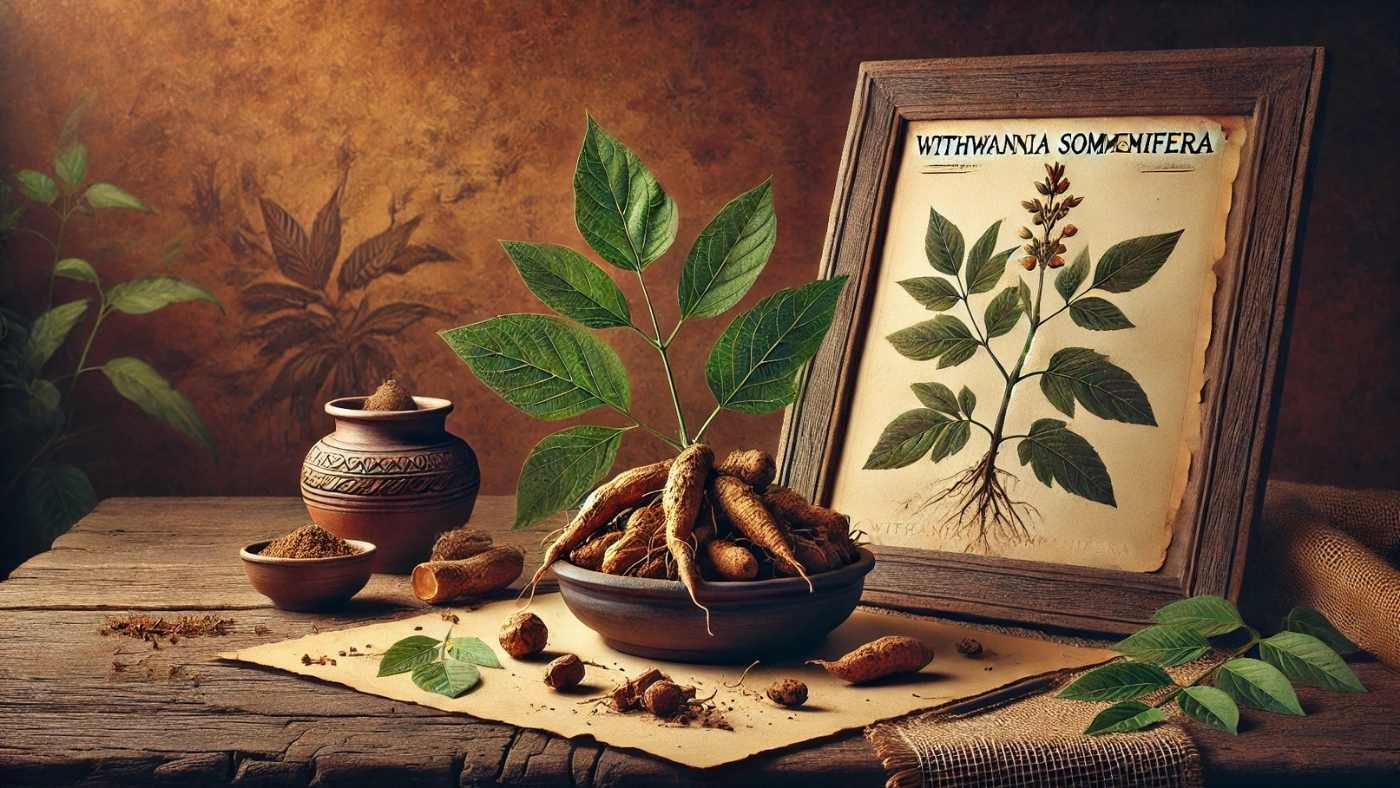Ashwagandha: Where Does It Grow? Discover Its Origins

Ashwagandha, or Withania somnifera, is a small shrub with yellow-green flowers and red berries.
Its name translates from Sanskrit to “smell of the horse,” an homage to its earthy fragrance and rejuvenating properties.
This herb has been foundational to Ayurvedic medicine for thousands of years, prized for its support of the stress response, stamina, and focus (1).
Botanical Profile and Origin
Ashwagandha is in the nightshade family, Solanaceae — as are tomatoes and peppers.
It came from the arid, nutrient-dense soils of India and North Africa, but naturally developed into a way to survive in that environment.
Traditional healers found that the roots have potent adaptogens, substances that help the body deal with stress (2).
Why It’s Called “Indian Ginseng”
Not related to ginseng botanically, ashwagandha receives the nickname “Indian ginseng” for its revitalizing effects.
It encourages peace between the mind and body — a philosophy that sits well with Wild Foods’ goal of living in accordance with nature.

Ashwagandha: Where Does It Grows Naturally?
Origins: Ashwagandha is native to the warm, semi-arid areas of India (3).
It grows where most plants struggle — in full sun with sparse rainfall and loose, well-draining soils.
Native Areas — India, Nepal, and the Middle East
Its native range runs from India through Nepal and into the Middle East to Yemen and Saudi Arabia.
In India, it flourishes particularly well in the dry plains of Rajasthan, Madhya Pradesh, and Gujarat.
These regions offer the perfect combination of warmth and limited moisture — conditions that result in strong, nutrient-dense roots.
Global Growth — From India to the Americas
As time passed, ashwagandha then spread outside of Asia to Africa, the Mediterranean and even sections of the Americas.
Today, it’s grown in places like Texas, Arizona, and California, where the hot and dry climate reflects its original environment.
This worldwide migration is a testament to the herb’s hardiness as well as the increasing global interest in natural health.
The Perfect Climate for Ashwagandha to Thrive
The ideal temperature for growing ashwagandha ranges from 70-95°F (21-35°C).
It is not frost-tolerant and does best in full sun, low-humidity locations.
The sandy or loamy soil, low-level watering makes the roots grow dense compound properties.

From Seed to Root: The Growth Process
Seeds: The life of ashwagandha starts out as small brown seeds.
When sown, they germinate within approximately 14 days when kept warm.
The plant is full-grown in five to six months, at which time its leaves begin to yellow and dry up - this is when it is harvested.
Soil and Water Needs
Ashwagandha can thrive where other crops might die — on sandy, rocky soil with very little water.
All it needs is a little moisture to get itself going, yet it grows best when the soil can go a bit dry between drinks.
But that resilience is one reason the herb was so easily adopted as a symbol — strength in adversity.
Sustainability and Ethical Harvesting
Given that so much of the world wants it, sustainability matters more than ever.
Responsible sourcing means you will get to enjoy your ashwagandha without guilt for the planet.
Wild Foods works with small, sustainable farms that value the land and those harvesting from it — so each root helps support good health as well as environmental harmony (4).
Can Ashwagandha Be Grown at Home?
Yes, you may grow ashwagandha in your own backyard or a pot on your balcony.
It’s surprisingly undemanding and hugely satisfying to grow.

Growing Ashwagandha from Seed
Begin by soaking the seeds for at least one night to promote faster germination.
Plant them in well-draining soil about half an inch deep. They should be kept warm and lightly moist until they sprout.
Once settled into the soil, back off on watering — these dry conditions will suit the plant.
How to Grow Ashwagandha in Pots or Garden
If you have limited space, pick a large pot at least 12 inches deep.
Make sure it gets full sun for six to eight hours a day.
Do not overwater — a soggy solution can rot the roots and dilute their strength.
Harvesting and Drying Ashwagandha Roots
Harvest your ashwagandha approximately five months after planting, when the leaves will start to shrivel.
Excavate the roots carefully and wash with water before they are dried in a cool, well-draughted place.
Once they are dried, however, you can powder them up for teas, tinctures, or capsules.
If you prefer ready-to-go, high-quality adaptogens, consider Wild Foods Organic Ashwagandha Root Powder — harvested ethically and tested in the lab for purity.
Where It Grows and How Potent It Is
The nutritional profile of ashwagandha is dependent on the climate in which it grows.
Roots grown in dry, mineral-rich soil contain more withanolides — the active constituents that endow the herb with its adaptogenic prowess (5).
Soil Minerals and Phytochemical Strength
The more natural, chemically unpolluted the soil in which Ashwagandha is grown, the more antioxidants and active principles it possesses.
The Good Wine If wine is a mirror of its vineyard, then ashwagandha belongs to its soil.
Final Thoughts
From the arid plains of India to contemporary kitchens around the globe, ashwagandha has traveled in ways that are reflective of our own — robust, rooted, and malleable.
Knowing where ashwagandha grows lets you understand why this root has so much power and healing properties.
In the same way that the plant draws from its roots to dry soil, so too can you flourish by tuning back into nature’s beat.
Embody that harmony with Wild Foods’ Ashwagandha Root Powder, a pure and sustainably sourced path to reWild your health.
🌿 Reclaim Your Calm — Naturally! Balance stress, boost vitality, and feel centered again with Daily Nutra KSM-66 Ashwagandha. Start your rewilded wellness journey today! 🌿
FAQs about Ashwagandha: Where Does it Grow?
Where does ashwagandha grow naturally?
Ashwagandha is indigenous to the dry, sub-tropical regions of India, Nepal, and the Middle East.
Is it possible to grow aswagandha in the United States?
Yes, it fares well in warm U.S. climates such as California, Texas, and Florida.
How long does Ashwagandha take to grow from seed?
Ashwagandha seed to harvest takes approximately 150 – 180 days.
Can ashwagandha be grown indoors or in pots?
Yes, it does well in pots provided it gets some sunshine and a well-drained soil.
Which soil is good for ashwagandha?
Plant carrots in well-drained, easily worked soil with low moisture and good drainage for strong root development.
Related Studies
1. Title: Effects of Withania somnifera (Ashwagandha) on Stress and Anxiety: A Systematic Review and Meta-analysis of Randomized Controlled Trials
This randomized controlled trial meta-analysis with several hundred participants shows that ashwagandha supplementation significantly lowers stress and cortisol levels compared to placebo.
Link: https://www.ncbi.nlm.nih.gov/pmc/articles/PMC8762185/
2. Title: Study of Drug Target Identification and Associated Molecular Mechanisms of Withania somnifera (Ashwagandha) Extracts
This biochemical study details the adaptogenic and neuroprotective mechanisms of withanolides, highlighting their effects on oxidative stress pathways and inflammation regulation.
Link: https://www.ncbi.nlm.nih.gov/pmc/articles/PMC10560109/
3. Title: Plant Inventory No. 149 (covering Withania somnifera distribution)
Botanical surveys confirm the native range of ashwagandha across India, Nepal, and parts of the Middle East, thriving in warm, semi-arid climates.
Link: https://www.ars-grin.gov/npgs/pi_books/scans/pi149.pdf
4. Title: Current demands for standardization of Indian medicinal plants including sustainability of smallholder farms
This study discusses the benefits of small-scale and regenerative farming practices on medicinal herbs like ashwagandha, emphasizing soil regeneration and sustainable cultivation's positive environmental impact.
Link: https://www.sciencedirect.com/science/article/pii/S2590098625000089
5. Title: Organic cultivation of Ashwagandha with improved root yield and withanolide content
This agricultural study links soil mineral composition and organic cultivation methods to higher concentrations of withanolides in ashwagandha roots.
Link: https://www.ncbi.nlm.nih.gov/pmc/articles/PMC5901777/
